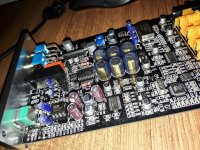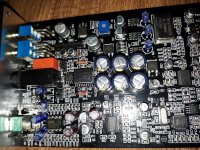That has been my challenge every time I picked location sound, in dialogue or music situations. Picking the mic and mic position is crucial for that. Once I recorded a piano quite badly because of that. But I learned from that and it never happened again. For dialogue it's also quite tricky, as you can affect a performance with a mic position. If you are doing tests you must pick your reference recordings, and it certainly gets confused on some mixes. A friend of mine used a Low Rawls CD for a long time to check the high quality speakers he makes. The CD was impeccable. For me the most difficult task is to make a mono track sound as well as if it were stereo, going from wall to wall and filling up a room.
Last edited by a moderator:
Why can't engineers and audiophiles meet in the middle and both acknowledge there might something valid on what the other is claiming?
Exactly carl
That is what I 've been saying from the start. Keep an open mind.We are on the same side after all.
Last edited by a moderator:
Hi carlmart,
I also agree with much of what you have said, and if anyone checks my posting history I have always said that you need to both measure and listen. When those two things are in agreement you are following the right path.
The major difference in testing is that some people are still assuming a simple 'scope or THD meter tests. Even if you use a spectrum analyser (much more helpful) you can't see the fine details you need to. However, once you hang a really good spectrum analyser off the monitor output of a good THD meter, interesting things pop up. It is here that you have to learn how to interpret the results and where you can see what is being heard. This is reasonably advanced and still will not work with budget test equipment. This is where what you hear can be seen and measured. The accuracy isn't too good due to the noise floor, and hopefully we will see more as equipment gets better. If I had current equipment, then I'm absolutely positive the results could be quantified.
I'll say it again. If you can hear it, it can be seen in my case. We are measuring things below -100 dBu and averaging drops the noise floor until these aberrations come into view. I think Demian and a few others probably do this. Richard likely can as well.
-Chris
True, very true.It's not much use to answer or comment specifically each statement of this discussion. I have been reading similar ones over the years, and rarely do they seem to get anywhere.
I also agree with much of what you have said, and if anyone checks my posting history I have always said that you need to both measure and listen. When those two things are in agreement you are following the right path.
The major difference in testing is that some people are still assuming a simple 'scope or THD meter tests. Even if you use a spectrum analyser (much more helpful) you can't see the fine details you need to. However, once you hang a really good spectrum analyser off the monitor output of a good THD meter, interesting things pop up. It is here that you have to learn how to interpret the results and where you can see what is being heard. This is reasonably advanced and still will not work with budget test equipment. This is where what you hear can be seen and measured. The accuracy isn't too good due to the noise floor, and hopefully we will see more as equipment gets better. If I had current equipment, then I'm absolutely positive the results could be quantified.
I'll say it again. If you can hear it, it can be seen in my case. We are measuring things below -100 dBu and averaging drops the noise floor until these aberrations come into view. I think Demian and a few others probably do this. Richard likely can as well.
-Chris
I'm a diyer who grew up in a house with tube amps, and musical instruments around as well. My teenage years were spent listening to louder music, live music, but now enjoy tweaking and tuning, power supplies are a big part of this, haven't used my scope yet for audio. So far my favorite filter capacitors are epcos sikorel, Mundorf ag, epcos b41505, Nichicon FZ. Local decoupling is either Silmic ars, or Panasonic pureism, found on eBay and sometimes older than one would prefer, but sound great regardless. Noticed these are getting scarce lately though. New blackgates might be worth a listen, wasn't in the game the first time...
Last edited by a moderator:
Oh man I have come close to using the scope, but so far have figured it out the hard way I guess. I really should start to get used to using that also.
The two flavors of parts are shared in my contraptions, usually the Panasonic on lower powered dac chips, Silmic closer to the output, but not always.
The two flavors of parts are shared in my contraptions, usually the Panasonic on lower powered dac chips, Silmic closer to the output, but not always.
We spend the majority of our time listening at average power levels of perhaps 1 watt, often less. We can measure down to the noise floor, but no lower.
The majority of our listening is at low power levels, where the THD + Noise is rising compared to higher power levels. We can hear below the noise floor.
How do we reconcile the fact that we cannot "see" what is going on below the noise floor, but can hear it? We listen.
The majority of our listening is at low power levels, where the THD + Noise is rising compared to higher power levels. We can hear below the noise floor.
How do we reconcile the fact that we cannot "see" what is going on below the noise floor, but can hear it? We listen.
Last edited by a moderator:
I regularly measure distortion harmonics ~50dB below the broadband noise level of the signal using an FFT, which has frequency discrimination properties somewhat similar to the cilia in our cochleae. So, we can measure and hear below the noise floor, if you do it right! ;-)
Hi.We all know that Elna silmic and Rubycon bg caps sound good and there is a good comprasion at Eric Juaneda web site about them.However Elna silmic caps does not have a long lifespan and i am curious about long life Philips/BC/Vishay radial caps which i have plenty of them in stock.There is Panasonic FC caps in my headphone dac/amp connected to headamp chip and i want to replace them with some BC/roe/philips brand caps without burning the pcb before my Daart canary arrives.Which series of BC caps will be a sound quality improvement over Panasonic FC caps?(FC caps have 10x12,5mm dimensions ,5mm lead distance and fx audio dac x6 space allows up to 10x16mm caps)
036 RSP
046 RSL
048 RML
116 RLL
135 RLI
136 RVI
150 RMI
Roe vishay eke
Roe vishay ekc
roe eks
They are all described as to be used in audio circuits in datasheet.Has anyone tried some of these caps and tell something about their sound quality compared to FC caps?Which of them sounds best?
Thank you and best regards
036 RSP
046 RSL
048 RML
116 RLL
135 RLI
136 RVI
150 RMI
Roe vishay eke
Roe vishay ekc
roe eks
They are all described as to be used in audio circuits in datasheet.Has anyone tried some of these caps and tell something about their sound quality compared to FC caps?Which of them sounds best?
Thank you and best regards
Attachments
Last edited:
Here's my $0.01 worth, never tried and possibly never will. I no longer go by people's impression on the WWW. Getting burnt once is enough! Most of these So called "audiophile" or "audio grade" caps do not specify certain specifications in the data sheet like normal caps. So beware! At least the Panasonic FC gives you all the figures you need and they measure closely to the values specified. We all hear differently due to DNA, noise exposure and age, we are subjective in what we recommend! And what we like is personal! I believe the Nichicons that are simular to the Panasonic FC are very good but never tried them.
- Home
- Design & Build
- Parts
- Best electrolytic capacitors

